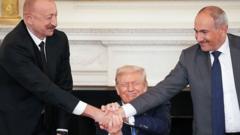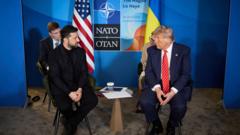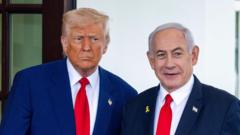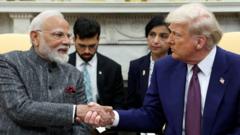In a significant diplomatic milestone, Azerbaijan and Armenia formalized a peace deal at a summit hosted by President Trump, marking an end to decades of conflict and hostility in the region.
Historic Peace Agreement Signed Between Azerbaijan and Armenia at White House Summit

Historic Peace Agreement Signed Between Azerbaijan and Armenia at White House Summit
A groundbreaking pact aims to resolve long-standing tensions between the two nations, with the US playing a key role as a mediator.
On Friday, the leaders of Azerbaijan and Armenia gathered at the White House to sign an agreement focused on fostering peace and revitalizing economic ties after years of animosity driven by the dispute over Nagorno-Karabakh. President Trump heralded the event as "historic," emphasizing that it was a long-awaited resolution to the ongoing conflict that erupted during the late 20th century.
Azerbaijan’s President Ilham Aliyev and Armenian Prime Minister Nikol Pashinyan shook hands in a moment symbolizing the commitment to lasting peace. The agreement includes provisions to reopen crucial transport routes between the two nations, enhancing connectivity and cooperation. “We are today establishing peace in the Caucasus," Aliyev expressed, stressing the importance of moving beyond a history marred by wars and bloodshed.
Trump noted that both nations pledged to cease hostilities "forever" and to establish open lines for travel, commerce, and diplomatic exchanges. Reflecting on the significance of the agreement, Pashinyan described it as a crucial turning point in Armenia-Azerbaijan relations. "Thirty-five years they fought, and now they're friends," Trump remarked, encapsulating the hope for a new era of friendship between the countries.
A key aspect of the agreement is the establishment of a transit corridor named the Trump Route, which will connect Azerbaijan with its Nakhchivan exclave, separated by Armenian territory. This corridor has been a contentious point in past negotiations, and the deal aims to alleviate previous tensions surrounding its control.
The summit also included a bilateral agreement aimed at expanding energy and technology trade between the two nations, showcasing the growing U.S. influence in the Caucasus at the expense of Russia’s long-standing role as mediator in the region. With Russian President Vladimir Putin historically overseeing negotiations in this conflict, the new agreement signifies a shift in dynamics, as both countries opted for an American-led solution.
As the summit concluded, Trump foreshadowed upcoming discussions with Putin, set to take place in Alaska next week, hinting at ongoing complexities in international relations surrounding the region’s peace efforts. While optimism flourished at the summit, lingering apprehensions about potential conflict remain among the Armenian population, wary of a volatile history not easily forgotten.
Azerbaijan’s President Ilham Aliyev and Armenian Prime Minister Nikol Pashinyan shook hands in a moment symbolizing the commitment to lasting peace. The agreement includes provisions to reopen crucial transport routes between the two nations, enhancing connectivity and cooperation. “We are today establishing peace in the Caucasus," Aliyev expressed, stressing the importance of moving beyond a history marred by wars and bloodshed.
Trump noted that both nations pledged to cease hostilities "forever" and to establish open lines for travel, commerce, and diplomatic exchanges. Reflecting on the significance of the agreement, Pashinyan described it as a crucial turning point in Armenia-Azerbaijan relations. "Thirty-five years they fought, and now they're friends," Trump remarked, encapsulating the hope for a new era of friendship between the countries.
A key aspect of the agreement is the establishment of a transit corridor named the Trump Route, which will connect Azerbaijan with its Nakhchivan exclave, separated by Armenian territory. This corridor has been a contentious point in past negotiations, and the deal aims to alleviate previous tensions surrounding its control.
The summit also included a bilateral agreement aimed at expanding energy and technology trade between the two nations, showcasing the growing U.S. influence in the Caucasus at the expense of Russia’s long-standing role as mediator in the region. With Russian President Vladimir Putin historically overseeing negotiations in this conflict, the new agreement signifies a shift in dynamics, as both countries opted for an American-led solution.
As the summit concluded, Trump foreshadowed upcoming discussions with Putin, set to take place in Alaska next week, hinting at ongoing complexities in international relations surrounding the region’s peace efforts. While optimism flourished at the summit, lingering apprehensions about potential conflict remain among the Armenian population, wary of a volatile history not easily forgotten.




















